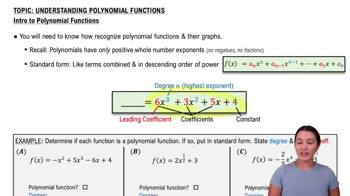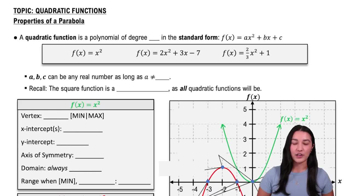Table of contents
- 0. Functions7h 52m
- Introduction to Functions16m
- Piecewise Functions10m
- Properties of Functions9m
- Common Functions1h 8m
- Transformations5m
- Combining Functions27m
- Exponent rules32m
- Exponential Functions28m
- Logarithmic Functions24m
- Properties of Logarithms34m
- Exponential & Logarithmic Equations35m
- Introduction to Trigonometric Functions38m
- Graphs of Trigonometric Functions44m
- Trigonometric Identities47m
- Inverse Trigonometric Functions48m
- 1. Limits and Continuity2h 2m
- 2. Intro to Derivatives1h 33m
- 3. Techniques of Differentiation3h 18m
- 4. Applications of Derivatives2h 38m
- 5. Graphical Applications of Derivatives6h 2m
- 6. Derivatives of Inverse, Exponential, & Logarithmic Functions2h 37m
- 7. Antiderivatives & Indefinite Integrals1h 26m
- 8. Definite Integrals4h 44m
- 9. Graphical Applications of Integrals2h 27m
- 10. Physics Applications of Integrals 2h 22m
4. Applications of Derivatives
Motion Analysis
Problem 3.6.27
Textbook Question
Initial velocity Suppose a baseball is thrown vertically upward from the ground with an initial velocity of v0ft/s Its height above the ground after t seconds is given by s(t) = -16t²+v0t. Determine the initial velocity of the ball if it reaches a high point of 128 ft.
 Verified step by step guidance
Verified step by step guidance1
Identify the formula for the height of the baseball: \( s(t) = -16t^2 + v_0t \).
Recognize that the high point of the ball is reached when its velocity is zero. The velocity function is the derivative of the height function: \( v(t) = \frac{d}{dt}(-16t^2 + v_0t) = -32t + v_0 \).
Set the velocity function equal to zero to find the time \( t \) when the ball reaches its highest point: \( -32t + v_0 = 0 \). Solve for \( t \) to get \( t = \frac{v_0}{32} \).
Substitute \( t = \frac{v_0}{32} \) into the height function \( s(t) = -16t^2 + v_0t \) and set it equal to 128 ft, the maximum height: \( -16\left(\frac{v_0}{32}\right)^2 + v_0\left(\frac{v_0}{32}\right) = 128 \).
Simplify and solve the equation for \( v_0 \) to determine the initial velocity of the ball.
 Verified video answer for a similar problem:
Verified video answer for a similar problem:This video solution was recommended by our tutors as helpful for the problem above
Video duration:
5mPlay a video:
Was this helpful?
Key Concepts
Here are the essential concepts you must grasp in order to answer the question correctly.
Quadratic Functions
The height of the baseball is modeled by a quadratic function, s(t) = -16t² + v0t, where the term -16t² represents the effect of gravity. Quadratic functions have a parabolic shape, and their maximum or minimum points can be found using the vertex formula. In this case, the vertex represents the highest point the baseball reaches.
Recommended video:

Introduction to Polynomial Functions
Vertex of a Parabola
The vertex of a parabola given by the equation s(t) = at² + bt + c can be found using the formula t = -b/(2a). This point gives the maximum height when the parabola opens downwards, as in this scenario. Understanding how to find the vertex is crucial for determining the time at which the baseball reaches its highest point.
Recommended video:

Properties of Parabolas
Initial Velocity
Initial velocity, denoted as v0 in the equation, is the speed at which the baseball is thrown upward. It directly influences how high the baseball will rise before gravity pulls it back down. To find the initial velocity when the baseball reaches a height of 128 ft, we can substitute the height into the height equation and solve for v0.
Recommended video:

Initial Value Problems Example 2

 6:29m
6:29mWatch next
Master Derivatives Applied To Velocity with a bite sized video explanation from Nick
Start learning




